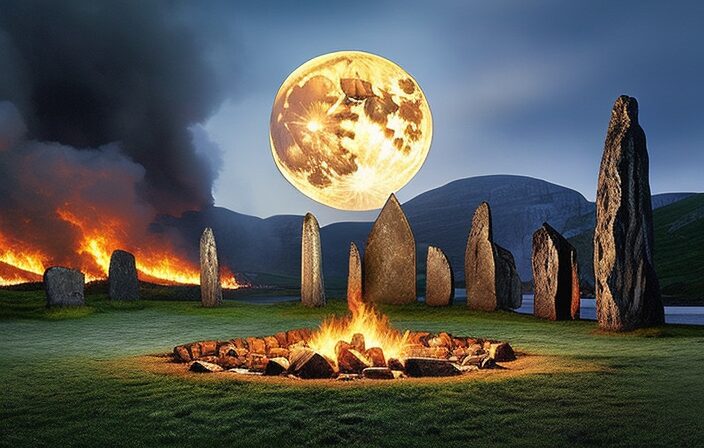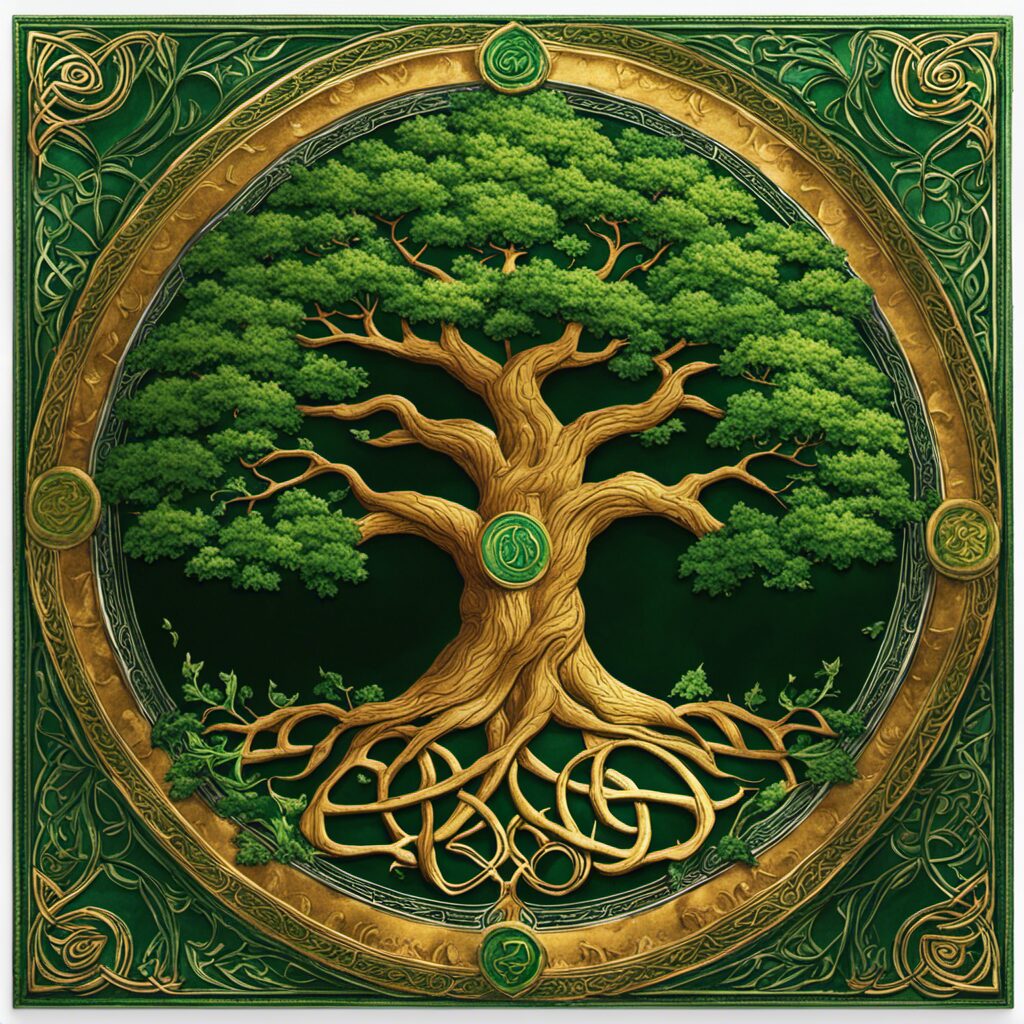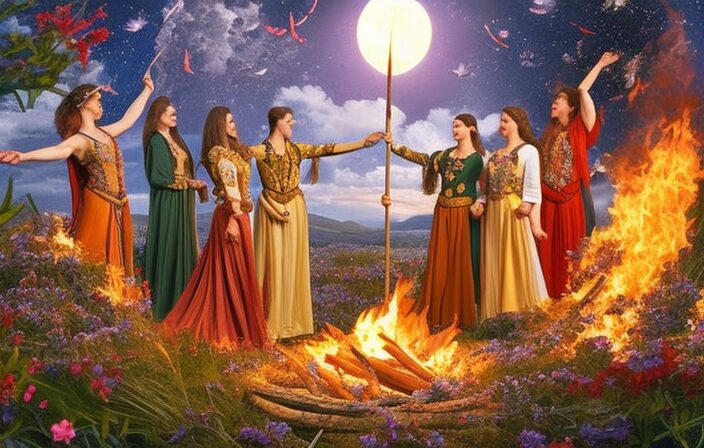The Celtic calendar and its associated storytelling traditions are subjects of great significance in studying the cultural heritage of the Celtic people.
This article aims to explore the origins and structure of the Celtic calendar, known as the Wheel of the Year, as well as its role in shaping festivals and celebrations within Celtic culture.
Additionally, it will examine how storytelling played a crucial role in conveying mythological narratives and folklore within Celtic society.
Furthermore, this article will investigate the influence of the Celtic calendar on contemporary storytelling practices.
Through an objective analysis grounded in research, this article seeks to provide a comprehensive understanding of the interplay between the Celtic calendar and storytelling traditions.
Key Takeaways
- The Celtic calendar emerged around 1200 BCE in Central Europe and was rooted in ancient agricultural and astronomical practices.
- The calendar was based on lunar cycles and divided into fortnights, with symbolic meanings assigned to natural phenomena.
- Seasonal celebrations and rituals tied to the Celtic calendar reflected the connection between human life and nature, with storytelling playing a powerful role.
- The Celtic calendar influenced various aspects of literature and storytelling techniques, providing inspiration for narrative structure, theme development, and the incorporation of landscapes, animals, and natural phenomena.
The Origins of the Celtic Calendar


The origins of the Celtic calendar are believed to be rooted in ancient agricultural and astronomical practices. The Celtic culture, which emerged around 1200 BCE in Central Europe, relied heavily on agriculture for sustenance and survival. As such, the cycles of nature played a crucial role in their daily lives and shaped their understanding of time.
Agricultural practices such as sowing, harvesting, and livestock management were closely tied to celestial events like solstices and equinoxes. The movements of the sun, moon, and stars provided valuable information about when to plant crops or move animals to different grazing areas.
The Celts also had a deep reverence for nature and believed that it was imbued with spiritual significance. They assigned symbolic meanings to various natural phenomena, including celestial bodies. This belief system further influenced their development of a calendar that incorporated both agricultural and astronomical observations.
While specific details about the earliest versions of the Celtic calendar are scarce due to limited surviving records from that period, it is widely accepted that it was based on lunar cycles rather than solar ones. Lunar months were divided into fortnights or ‘half-months,’ corresponding roughly to two weeks each.
The Wheel of the Year
Seasonal celebrations and rituals are an integral part of the Wheel of the Year, a concept that encompasses various pagan and neopagan traditions. These celebrations are often tied to the changing seasons and agricultural cycles, reflecting the close connection between human life and nature.
Symbolism in nature plays a significant role in these celebrations, with elements such as plants, animals, and natural phenomena representing deeper meanings and spiritual concepts.
Additionally, storytelling serves as a powerful tool for transmitting knowledge, preserving cultural traditions, and fostering a sense of community within these seasonal celebrations.
Seasonal Celebrations and Rituals
Throughout the Celtic calendar, various celebrations and rituals were observed to mark significant moments in time. These seasonal customs and traditional ceremonies were deeply rooted in the agricultural cycle and reflected the interconnectedness between nature and human life.
The following bullet points provide a deeper understanding of these customs:
-
Samhain: Celebrated on November 1st, it marked the end of the harvest season and the beginning of winter. It was believed that on this day, the boundary between the living and spirit world was thinnest.
-
Imbolc: Observed on February 1st, it celebrated the return of spring and honored Brigid, goddess of fertility and healing. It involved purification rituals to cleanse both land and individuals.
-
Beltane: Celebrated on May 1st, it welcomed summer with fire festivals symbolizing purification and protection against harmful forces.
-
Lughnasadh: Occurring on August 1st, it commemorated the first harvest of grains. Festivities included games, feasting, and communal gatherings.
These seasonal celebrations embodied a deep respect for nature’s cycles while fostering community bonds through shared traditions.
Symbolism in Nature
Symbolism in nature played a significant role in the seasonal celebrations and rituals of the Celtic calendar. The ancient Celts had a deep connection to the natural world, and they believed that various elements of nature held symbolic meanings.
For example, trees were seen as sacred beings that served as gateways between different realms. The oak tree represented strength and endurance, while the holly tree symbolized protection and resilience.
Animals also held symbolic significance in Celtic lore. The stag was associated with fertility and abundance, while the salmon represented wisdom and knowledge.
These symbols were integrated into seasonal celebrations and rituals, helping to create a sense of harmony between humans and nature. By incorporating symbolism in their practices, the Celts sought to honor and align themselves with the natural rhythms of life.
Role of Storytelling
Narratives passed down through generations were integral to the cultural practices of the ancient Celts, as they conveyed important teachings and values to their communities. The oral tradition played a crucial role in preserving their culture and ensuring its continuity over time. Through storytelling, the Celts were able to pass on their history, mythology, and spiritual beliefs from one generation to another. This form of cultural preservation allowed for the transmission of knowledge and traditions that shaped their identity as a community.
The importance of storytelling in Celtic culture can be seen through its ability to connect individuals with their roots, instill a sense of belonging, and provide moral guidance. It served as a means for social cohesion and contributed to the collective memory of the community.
- Oral tradition: A method of transmitting knowledge through spoken words rather than written texts.
- Cultural preservation: The act of safeguarding cultural heritage and traditions for future generations.
- Transmission of knowledge: The process by which information is passed on from one generation to another.
- Social cohesion: The bond that holds a society together through shared values, norms, and beliefs.
Festivals and Celebrations in Celtic Culture


Festivals and celebrations in Celtic culture played a significant role in social bonding and community cohesion. These events were an integral part of the Celtic calendar, which revolved around the cycles of nature and agricultural activities. The festivals served as opportunities for people to come together, not only to celebrate but also to reinforce their shared cultural identity.
One prominent festival in Celtic culture was Samhain, celebrated at the end of October or beginning of November. It marked the transition from autumn to winter and was associated with honoring ancestors and preparing for the dark months ahead.
Another important festival was Imbolc, held in early February, which marked the beginning of spring. It was a time for purification rituals and welcoming new life.
These festivals often involved various traditions that were passed down through generations. For example, Beltane, celebrated on May 1st, involved lighting bonfires symbolizing fertility and growth. Lughnasadh, held on August 1st, commemorated the harvest season with feasting and games.
By participating in these festivals and upholding their traditions, Celtic communities fostered a sense of belonging and unity among its members. These events provided opportunities for individuals to connect with each other while reinforcing their cultural heritage.
Festivals acted as a way to strengthen social bonds within Celtic society while simultaneously celebrating important natural phenomena throughout the year.
The Role of Storytelling in Celtic Society


The cultural significance of storytelling in Celtic society is undeniable, as it played a vital role in preserving and transmitting their history, values, and traditions.
Through oral tradition, the Celts passed down their rich narratives from one generation to another, ensuring the survival of their cultural heritage.
These stories encompassed mythology and folklore, providing insight into the beliefs and worldview of the Celts, shaping their identity as a community.
Cultural Significance of Storytelling
Storytelling in Celtic culture holds cultural significance as it serves to preserve and transmit ancestral knowledge and traditions. The oral storytelling techniques used by the Celts have been vital in the preservation of their cultural heritage. Through these stories, important aspects of Celtic society such as history, mythology, and moral values are passed down from one generation to another.
The following bullet points further highlight the deeper meaning behind Celtic storytelling:
-
Connection to nature: Celtic stories often revolve around natural elements like trees, rivers, and animals, reflecting a deep connection with the environment.
-
Sense of identity: Storytelling helps reinforce a sense of identity among the Celts, fostering pride in their heritage and strengthening communal bonds.
-
Spiritual beliefs: Many Celtic tales contain spiritual or supernatural elements that provide insights into their religious beliefs and practices.
-
Moral lessons: Stories often convey moral values such as bravery, loyalty, and honor, guiding individuals on how to navigate life’s challenges.
Overall, storytelling plays a crucial role in cultural preservation within Celtic society by ensuring that their traditions and wisdom continue to be shared across generations.
Oral Tradition and History
Oral tradition has been instrumental in preserving historical knowledge and passing it down through generations. This form of cultural heritage encompasses the transmission of information, beliefs, customs, and traditions from one generation to another through spoken word rather than written records.
Oral traditions have played a crucial role in societies worldwide by ensuring the continuity and preservation of cultural practices, history, and values. Through the oral transmission of stories, myths, legends, songs, proverbs, and rituals, communities have maintained their collective memory over time.
The reliance on oral tradition as a method of communication has allowed for the retention of cultural knowledge that might otherwise be lost or forgotten. Additionally, oral tradition enables the adaptation and evolution of narratives according to changing social contexts while maintaining their core elements.
Overall, oral tradition is an invaluable resource for understanding cultural heritage and its significance in shaping societies throughout history.
Mythology and Folklore Impact
Mythology and folklore have had a profound influence on various aspects of society, including literature, art, religion, and cultural identities. These ancient narratives and traditions shape our understanding of the world and provide insight into human experiences across time and cultures.
The impact of mythology can be seen in the way it inspires literary works such as epics, poems, and novels that incorporate mythological themes or characters. Similarly, art often draws upon mythological motifs to convey deeper meanings or symbolism.
Religion is also heavily influenced by mythology, with many religious beliefs incorporating mythical stories into their teachings and rituals.
Finally, mythology plays a crucial role in shaping cultural identities by providing a shared set of stories and symbols that connect individuals within a community.
- Mythology inspires creativity in literature.
- Art incorporates mythological motifs for symbolic purposes.
- Religious beliefs are influenced by mythical stories.
- Mythology fosters a sense of communal identity through shared narratives and symbols.
Mythology and Folklore in Celtic Traditions
The transmission of cultural beliefs and traditions through the use of narratives has played a significant role in Celtic communities, encompassing various mythological and folkloric elements. Celtic mythology is rich with tales of mythological creatures, such as fairies, dragons, and shape-shifters, which are often depicted as powerful beings with supernatural abilities. These mythological creatures are woven into the fabric of Celtic traditions, appearing in ancient rituals that were performed to honor deities or mark important occasions.
Ancient Celtic rituals were deeply rooted in nature and reflected the close relationship that Celtic communities had with their environment. Many of these rituals involved invoking the aid or protection of specific mythological creatures associated with certain natural elements or forces. For example, the practice of leaving offerings for fairies at sacred sites was believed to ensure good fortune and protection from misfortune.
Furthermore, storytelling served as a means to preserve and transmit cultural knowledge from one generation to another. Through these narratives, myths and legends were passed down orally over centuries, allowing individuals within the community to connect with their ancestral roots and understand their place within the larger cosmic order.
The Influence of the Celtic Calendar on Modern Storytelling


The influence of the Celtic calendar on modern storytelling can be observed in the way narratives are structured and themes are developed. The Celtic calendar, with its distinct divisions and associations with nature, has provided a rich source of inspiration for writers and storytellers throughout history. This influence is evident in various aspects of literature, particularly in terms of storytelling techniques.
-
Seasonal symbolism: The Celtic calendar is closely linked to the changing seasons, with each season having its own significance and symbolism. Writers often incorporate these symbols into their narratives to enhance the emotional impact or convey deeper meanings.
-
Rituals and celebrations: The festivals and rituals associated with the Celtic calendar serve as important plot devices or settings in many stories. These events not only add authenticity to the narrative but also provide opportunities for character development and conflict.
-
Cycle of life: The cyclical nature of the Celtic calendar mirrors the cycles of birth, growth, death, and rebirth found in many traditional narratives. This theme resonates with readers on a subconscious level and adds depth to their understanding of characters and plotlines.
-
Connection to nature: The Celtic calendar’s close connection to nature inspires writers to incorporate elements such as landscapes, animals, and natural phenomena into their stories. By doing so, they create a sense of realism while also emphasizing humanity’s relationship with the natural world.
Conclusion
In conclusion, the Celtic calendar played a significant role in shaping the storytelling traditions of Celtic culture.
The festivals and celebrations that were based on the Wheel of the Year provided a framework for community gatherings and the sharing of stories.
The mythology and folklore that emerged from these traditions continue to influence modern storytelling today.
It is interesting to note that according to research conducted by Celtic scholars, there are over 300 different versions of Celtic myths and legends, showcasing the rich diversity of storytelling within this ancient culture.




